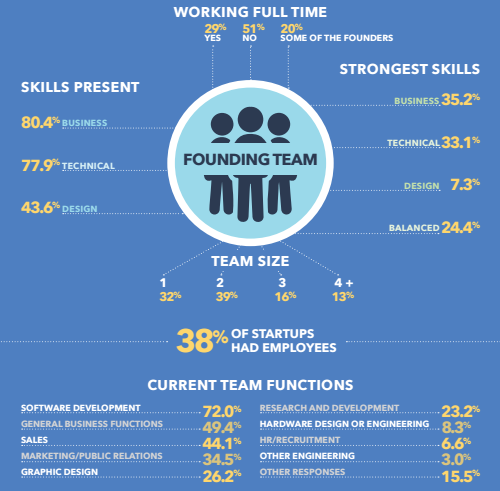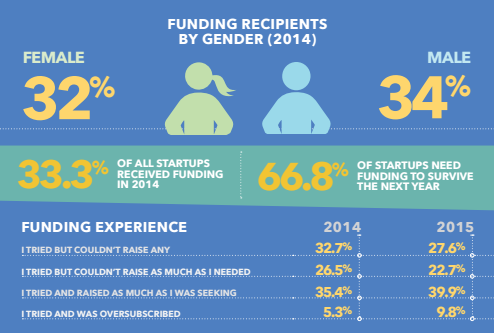
 In terms of gender statistics, the survey found that 24 percent of founders were female, up from 19 percent the year before. With 2015 having been a bit of a watershed year for initiatives aimed at both women already in tech and getting women into tech -initiatives such as Springboard Enterprises, Rare Birds, and Forming Circles Global, to name just a few - one could expect this figure to rise again next year. The Startup Muster figure reflects that of another study conducted earlier this year; a survey of women founders from Terem Technologies said they expect their ranks to grow quickly over the next five years, with more women realising that a solid idea is more important than tech skills when launching a startup.
This reasoning was seen across the board. According to Startup Muster, with 35.2 percent of respondents stating that their strongest skills lay in business and 33.1 percent on the technical side. Just 27 percent of respondents had worked in technology prior to launching their startup, with 23 percent having come from finance, and 13 percent having come from the education sector. This perhaps explains the strength of Australia's fintech and edutech sectors.
In terms of gender statistics, the survey found that 24 percent of founders were female, up from 19 percent the year before. With 2015 having been a bit of a watershed year for initiatives aimed at both women already in tech and getting women into tech -initiatives such as Springboard Enterprises, Rare Birds, and Forming Circles Global, to name just a few - one could expect this figure to rise again next year. The Startup Muster figure reflects that of another study conducted earlier this year; a survey of women founders from Terem Technologies said they expect their ranks to grow quickly over the next five years, with more women realising that a solid idea is more important than tech skills when launching a startup.
This reasoning was seen across the board. According to Startup Muster, with 35.2 percent of respondents stating that their strongest skills lay in business and 33.1 percent on the technical side. Just 27 percent of respondents had worked in technology prior to launching their startup, with 23 percent having come from finance, and 13 percent having come from the education sector. This perhaps explains the strength of Australia's fintech and edutech sectors.
 The main reasons for launching a startup fit along the stereotypes often associated with the sector: 33.3 percent said they were dissatisfied with their previous job, while over 27 percent said a fun project had turned into a viable business, and 22.9 percent stated that inspiration had come from direct contact with startups.
Going against the stereotype, however, are the age statistics. When the mainstream thinks startups it may think Mark Zuckerberg in his college dorm room, but Startup Muster found that almost 24 percent of founders are aged between 30 to 35, and 18 percent are aged between 35 to 40. Again, there may have been some change here over 2015, given that universities around the country have been starting to engage with the sector this year, partnering with organisations within the startup ecosystem to launch various initiatives to encourage entrepreneurship among their student bodies.
Looking at where Australian startups are working, marketing, content and media, retail, big data, and the Internet of Things are seeing the most activity, with each sector taking in 12-13 percent of startups. Almost a quarter of startups reported that they had product market fit, 53 percent said they were getting close, and 22 percent said they had either a long way to go or no idea. Over 40 percent of startups reported that they were bringing in revenue, with 35 percent coming from subscription models and 19 percent from purchases through websites. The average annual revenue for startups bringing in revenue was $236,000.
Looking forward, the challenges facing startups are much the same as those reported in the first Startup Muster survey: customer acquisition was by far the biggest issue at 59 percent, with 41 percent of respondents concerned about funding, and 34 percent stating that product development was a challenge. As Startup Daily wrote in response to similar results in last year's survey, this indicates that founders are, for the most part, thinking with a customer first attitude and taking a more sustainable approach to building their business, rather than simply chasing a capital raise. Still, the survey also found that almost 67 percent of startups need funding to survive the next year, with over half the respondents stating they had either tried but couldn't raise any, or had raised some funding but not enough.
The main reasons for launching a startup fit along the stereotypes often associated with the sector: 33.3 percent said they were dissatisfied with their previous job, while over 27 percent said a fun project had turned into a viable business, and 22.9 percent stated that inspiration had come from direct contact with startups.
Going against the stereotype, however, are the age statistics. When the mainstream thinks startups it may think Mark Zuckerberg in his college dorm room, but Startup Muster found that almost 24 percent of founders are aged between 30 to 35, and 18 percent are aged between 35 to 40. Again, there may have been some change here over 2015, given that universities around the country have been starting to engage with the sector this year, partnering with organisations within the startup ecosystem to launch various initiatives to encourage entrepreneurship among their student bodies.
Looking at where Australian startups are working, marketing, content and media, retail, big data, and the Internet of Things are seeing the most activity, with each sector taking in 12-13 percent of startups. Almost a quarter of startups reported that they had product market fit, 53 percent said they were getting close, and 22 percent said they had either a long way to go or no idea. Over 40 percent of startups reported that they were bringing in revenue, with 35 percent coming from subscription models and 19 percent from purchases through websites. The average annual revenue for startups bringing in revenue was $236,000.
Looking forward, the challenges facing startups are much the same as those reported in the first Startup Muster survey: customer acquisition was by far the biggest issue at 59 percent, with 41 percent of respondents concerned about funding, and 34 percent stating that product development was a challenge. As Startup Daily wrote in response to similar results in last year's survey, this indicates that founders are, for the most part, thinking with a customer first attitude and taking a more sustainable approach to building their business, rather than simply chasing a capital raise. Still, the survey also found that almost 67 percent of startups need funding to survive the next year, with over half the respondents stating they had either tried but couldn't raise any, or had raised some funding but not enough.
 Almost 80 percent of startups said that, looking ahead to 2015, stated that they would continue to operate in Australia, while 40 percent said they would undertake a capital raising in Australia and 23 percent said they would look to raise overseas. Just 61 and 20 percent said they would stay in Australia and look to raise in Australia beyond 2015 respectively, raising old, familiar concerns about startups feeling the need to relocate overseas in order to grow.
But again, when considering this figure we must consider all that has happened across the Australian tech and startup landscape this year, particularly in terms of government support since the rise of Malcolm Turnbull to the office of Prime Minister and the spotlight he has shone on the industry. In the last few months we have seen unprecedented support and engagement from government thanks to Assistant Minister for Innovation Wyatt Roy, while on a state level, Victoria's Minister for Small Business, Innovation and Trade Philip Dalidakis has worked to keep and create startup jobs in Melbourne rather than send them overseas.
In light of all this, and the eagerly-awaited release of the government's Innovation Statement on Monday, the requests participants had for government back in January and February this year are particularly interesting to look at now. At the top of the list with 35 percent of responses was the allocation of funding and grants, while 25 percent indicated they wanted to see the providing of incentives to investors and founders. Third on the list was the implementing of ESOP reforms - something finally done in July after years of confusion.
In his foreword to the report, Wyatt Roy wrote that the government would be fostering a new approach that will, among other things, "generate greater co-operation between research, business and government on commercialisation" and "help attract capital to enable Australian startup businesses turn bright ideas into economic and commercial reality."
As the startup ecosystem grows, so too will Startup Muster. Cofounder Murray Hurps has stepped down as CEO to make way for cofounder Monica Wulff, who will be taking over the role in a full time capacity.
Wulff said, “Australia is truly on the precipice of something amazing, but the startup industry is a unique challenge to measure accurately. Thanks to the support of over 1,000 Australians, Startup Muster 2015 has been a success, but I'm most excited by what's coming in 2016.”
The full Startup Muster report can be viewed here.
Almost 80 percent of startups said that, looking ahead to 2015, stated that they would continue to operate in Australia, while 40 percent said they would undertake a capital raising in Australia and 23 percent said they would look to raise overseas. Just 61 and 20 percent said they would stay in Australia and look to raise in Australia beyond 2015 respectively, raising old, familiar concerns about startups feeling the need to relocate overseas in order to grow.
But again, when considering this figure we must consider all that has happened across the Australian tech and startup landscape this year, particularly in terms of government support since the rise of Malcolm Turnbull to the office of Prime Minister and the spotlight he has shone on the industry. In the last few months we have seen unprecedented support and engagement from government thanks to Assistant Minister for Innovation Wyatt Roy, while on a state level, Victoria's Minister for Small Business, Innovation and Trade Philip Dalidakis has worked to keep and create startup jobs in Melbourne rather than send them overseas.
In light of all this, and the eagerly-awaited release of the government's Innovation Statement on Monday, the requests participants had for government back in January and February this year are particularly interesting to look at now. At the top of the list with 35 percent of responses was the allocation of funding and grants, while 25 percent indicated they wanted to see the providing of incentives to investors and founders. Third on the list was the implementing of ESOP reforms - something finally done in July after years of confusion.
In his foreword to the report, Wyatt Roy wrote that the government would be fostering a new approach that will, among other things, "generate greater co-operation between research, business and government on commercialisation" and "help attract capital to enable Australian startup businesses turn bright ideas into economic and commercial reality."
As the startup ecosystem grows, so too will Startup Muster. Cofounder Murray Hurps has stepped down as CEO to make way for cofounder Monica Wulff, who will be taking over the role in a full time capacity.
Wulff said, “Australia is truly on the precipice of something amazing, but the startup industry is a unique challenge to measure accurately. Thanks to the support of over 1,000 Australians, Startup Muster 2015 has been a success, but I'm most excited by what's coming in 2016.”
The full Startup Muster report can be viewed here.
Image: Incoming Startup Muster CEO Monica Wulff. Source: Provided.